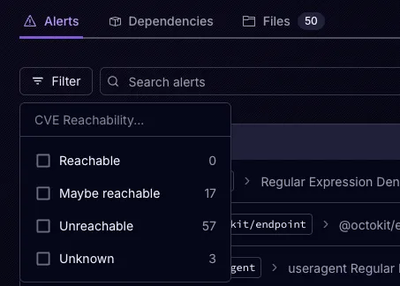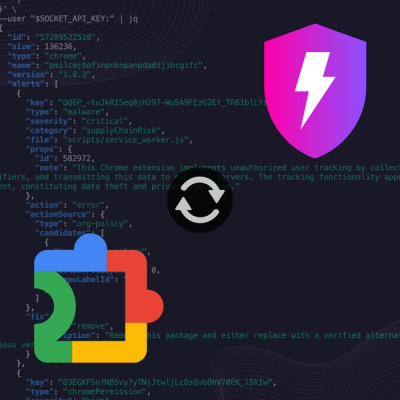
Product
Introducing Rust Support in Socket
Socket now supports Rust and Cargo, offering package search for all users and experimental SBOM generation for enterprise projects.
@expensify/react-native-wallet
Advanced tools
A React Native module designed for seamless integration of Card Push Provisioning into Apple Wallet and Google Wallet, enabling easy and secure addition of payment cards directly from your application.

Using the react-native-wallet Push Provisioning features requires proper configuration and access from both Google and Apple.
Please follow the instructions below before installing the library:
To be able to interact with the Google Wallet on the Android please make sure to complete all of the steps below following the Google Push Provisioning documentation:
Visit the Google Pay Android Push Provisioning API documentation and request access to it.
Once getting an approval from the Google team
/android/libs folder in your React Native project (if there is no libs folder, create one)./android/libs to .gitignore.Then connect the SDK to your project in build.gradle, for example like in example/android/build.gradle:
allprojects {
repositories {
google()
maven { url "file://${rootDir}/libs" }
}
}
To use the Google SDK in your app, you will need to whitelist your app details. Without it, calling some functions will result in a Not verified error.
To resolve it, please follow the instructions from the official Google documentation.
For your builds, you will need to prepare your app's package name and fingerprint following these steps. The values should, for example, look like this:
Package name: com.app.package.name
Fingerprint: SHA256: 36:38:63:59:6E:...:00:82:16:4E:FF
[!TIP] You can display your SHA-256 certificate checksum using
apksignerorkeytool.
With all the required data, submit the form and wait for Google's response. After successfully whitelisting your app you will be able to use Google SDK within our library.
To enable In-App Provisioning in your app, you must request activation of the appropriate Apple Pay entitlements for your developer Team ID. Enterprise Team IDs are not supported. This entitlement is not available by default in our panel; you will need to request it. Send an email to apple-pay-provisioning@apple.com with your app name, Team ID, and Adam ID.
Once Apple verifies your identity, you should get documentation named Getting Started with Apple Pay In-App Provisioning, Verification & Security. In this confidential document you will find all the relevant information about:
Make sure to familiarize yourself with that document before deploying your app.
After getting a positive response from Apple, open the developer portal panel and search Certificates, Identifiers & Profiles -> Profiles -> Our distribution profile -> Edit and add the ApplePay In-App Provisioning Distribution entitlement.
It’s available only for the production environment so your QA must work with physical devices and cards.
Add com.apple.developer.payment-pass-provisioning entitlement to your project. Find or create .entitlements file in your project and add the entitlement like below (similarly to WalletExample.entitlements):
<?xml version="1.0" encoding="UTF-8"?>
<!DOCTYPE plist PUBLIC "-//Apple//DTD PLIST 1.0//EN" "http://www.apple.com/DTDs/PropertyList-1.0.dtd">
<plist version="1.0">
<dict>
...
<!-- In-App Provisioning special entitlement-->
<key>com.apple.developer.payment-pass-provisioning</key>
<true/>
</dict>
</plist>
After completing the setup from the section above, install the react-native-wallet package from npm:
npm install @expensify/react-native-wallet
or
yarn add @expensify/react-native-wallet
Here you can find data elements used in the library, essential to work with Google Wallet and Apple Wallet APIs.
The library offers five functions for seamless integration and use of the Apple Wallet and Google Wallet APIs. Additionally, it includes one listener that informs when the added card has been activated. Below, these functions are described along with the data types involved.
| Function | Description | Parameters | Returns / Type | iOS | Android |
|---|---|---|---|---|---|
| getSecureWalletInfo | Returns necessary platform-specific wallet information for secure transactions. | None | WalletData | ✅ | ❌ |
| checkWalletAvailability | Checks if the wallet is ready and initializes it if possible. | None | boolean | ✅ | ✅ |
| getCardStatusBySuffix | Retrieves the current status of a card in the wallet. | lastDigits: string(The last few digits of the card number) | CardStatus | ✅ | ✅ |
| getCardStatusByIdentifier | Returns the state of a card based on a platform-specific identifier. On Android, it's Token Reference ID and on iOS, it's Primary Account Identifier. | identifier: string,tsp: string | CardStatus | ✅ | ✅ |
| addCardToGoogleWallet | Initiates native Push Provisioning flow for adding a card to the Google Wallet. | data: AndroidCardData | TokenizationStatus | ❌ | ✅ |
| addCardToAppleWallet | Initiates native Push Provisioning flow for adding a card to the Apple Wallet. | data: IOSCardData,issuerEncrypt-PayloadCallback: IOSIssuerCallback | void | ✅ | ❌ |
| Type | Description | Fields |
|---|---|---|
| AndroidWalletData | Specific information for Android devices required for wallet transactions. | deviceID: string,walletAccountID: string |
| AndroidCardData | Data related to a card that is to be added on Android platform wallets. | network: string,opaquePaymentCard: string,cardHolderName: string,lastDigits: string,userAddress: UserAddress |
| UserAddress | Structured address used for cardholder verification. | name: string,addressOne: string,addressTwo: string,city: string,administrativeArea: string,countryCode: string,postalCode: string,phoneNumber: string |
| IOSCardData | Data related to a card that is to be added on iOS platform. | network: string,activationData: string,encryptedPassData: string,ephemeralPublicKey: string,cardHolderTitle: string,cardHolderName: string,lastDigits: string,cardDescription: string,cardDescriptionComment: string |
| onCardActivatedPayload | Data used by listener to notice when a card’s status changes. | tokenId: string,actionStatus: 'activated' | 'canceled' |
| IOSIssuerCallback | This callback is invoked with a nonce, its signature, and a certificate array obtained from Apple. It is expected that you will forward these details to your server or the card issuer's API to securely encrypt the payload required for adding cards to the Apple Wallet. | (nonce: string, nonceSignature: string, certificate: string[]) => IOSEncryptPayload |
| IOSEncryptPayload | An object containing the necessary elements to complete the addition of a card to Apple Wallet. | encryptedPassData: string,activationData: string,ephemeralPublicKey: string |
| Type | Possible Values |
|---|---|
| CardStatus | not found, active, requireAuthorization, pending, suspended, deactivated |
| Listener | Event Description | Register Function | Unregister Function |
|---|---|---|---|
| cardActivation | Notifies when a card's status changes to activated. | addListener(event: string, callback: (data: onCardActivatedPayload) => void): EmitterSubscription | removeListener(subscription: EmitterSubscription): void |
AddToWalletButtonA ready-to-use component that simplifies the addition of payment cards to Google Wallet and Apple Wallet. The button automatically adapts its appearance according to the platform and language specified. It uses official assets provided by Google and Apple in their Wallet-related branding guidelines.
[!IMPORTANT] Please bear in mind the brand rules provided by Google and Apple when adding this component to your application.
Adhering to these guidelines is crucial not only to comply with legal requirements but also to reassure users of the authenticity and security of your application.
| Property | Type | Required | Description |
|---|---|---|---|
| onPress | () => void | Yes | A callback that is triggered when the button is pressed. |
| locale | string | Yes | The language code to display the correct button language. |
| platform | Platform (ios | android) | Yes | The platform type to ensure the appropriate button image is implemented. |
| buttonStyle | ViewStyle | No | Customizes the button style. |
<AddToWalletButton
onPress={() => console.log('Button pressed!')}
locale="en"
platform="android"
buttonStyle={{ height: 50 }}
/>
| Android | iOS |
|---|---|
To successfully publish your app, you will need to navigate through a series of mandatory test cases on both platforms.
Before deploying your app to the Google Play Store, make sure you have taken care of the security when implementing Push Provisioning and properly tested your code. To accomplish it, please familiarize yourself with the Google's App Push Provisioning best practices.
The latest information about deploying apps with Google TapAndPay SDK can be found in the pre-launch process and beta tests sections in Google documentation. Make sure to complete all of the steps specified by Google connected to the Google's branding, API safety, and app stability.
The app will need to be reviewed by Google. During this process, it will need to pass 4 mandatory test cases that are specified here. They verify how your app handles card state tracking in different scenarios.
[!NOTE] Please make sure to hide the
Add to Google Walletbuttons when cards are already added to the wallet.
When implementing the In-App Push Provisioning feature in your App make sure that your app follows Apple's branding guidelines connected to Apple Wallet. Remember that you must not create your own buttons or your app could be rejected at revision. You can use the AddWalletButton component instead!
When the pass is already provisioned, make sure to hide this button and replace it with text like Added to Apple Wallet. The card is fully provisioned once it added to your main device (user's iPhone) and all linked devices (for example Apple Watch).
Next to branding guidelines, please follow the instructions and best practices from the In-App provisioning documentation provided by Apple.
The In-App Provisioning feature must be reviewed and verified by Apple's certification team before submitting your app to the App Store. Below are some key scenarios that may be tested during the review process:
Apple may request a demonstration of certain test scenarios, such as verifying the ability to add up to twenty different cards for a single user. Be prepared to provide validation for such cases.
Additionally, when submitting your app to the App Store, you must include:
@expensify/react-native-wallet supports the three latest minor releases of react-native (0.76.0+)
Contributions to this library are done under https://github.com/Expensify/App. Please refer to that repo and all its guidelines for contributing.
MIT
This library is co-developed by Expensify, the fastest way to do expenses, travel, and corporate cards, in collaboration with Software Mansion, React Native core contributors and experts in building high-performing mobile solutions.

FAQs
A React Native module designed for seamless integration of Card Push Provisioning into Apple Wallet and Google Wallet, enabling easy and secure addition of payment cards directly from your application.
The npm package @expensify/react-native-wallet receives a total of 1,890 weekly downloads. As such, @expensify/react-native-wallet popularity was classified as popular.
We found that @expensify/react-native-wallet demonstrated a healthy version release cadence and project activity because the last version was released less than a year ago. It has 1 open source maintainer collaborating on the project.
Did you know?

Socket for GitHub automatically highlights issues in each pull request and monitors the health of all your open source dependencies. Discover the contents of your packages and block harmful activity before you install or update your dependencies.

Product
Socket now supports Rust and Cargo, offering package search for all users and experimental SBOM generation for enterprise projects.

Product
Socket’s precomputed reachability slashes false positives by flagging up to 80% of vulnerabilities as irrelevant, with no setup and instant results.

Product
Socket is launching experimental protection for Chrome extensions, scanning for malware and risky permissions to prevent silent supply chain attacks.